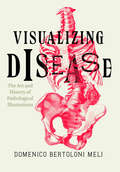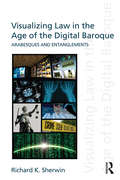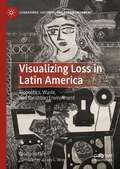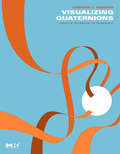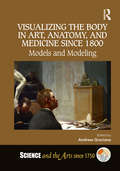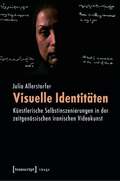- Table View
- List View
Visualizing Disease: The Art and History of Pathological Illustrations
by Domenico Bertoloni MeliVisual anatomy books have been a staple of medical practice and study since the mid-sixteenth century. But the visual representation of diseased states followed a very different pattern from anatomy, one we are only now beginning to investigate and understand. With Visualizing Disease, Domenico Bertoloni Meli explores key questions in this domain, opening a new field of inquiry based on the analysis of a rich body of arresting and intellectually challenging images reproduced here both in black and white and in color. Starting in the Renaissance, Bertoloni Meli delves into the wide range of figures involved in the early study and representation of disease, including not just men of medicine, like anatomists, physicians, surgeons, and pathologists, but also draftsmen and engravers. Pathological preparations proved difficult to preserve and represent, and as Bertoloni Meli takes us through a number of different cases from the Renaissance to the mid-nineteenth century, we gain a new understanding of how knowledge of disease, interactions among medical men and artists, and changes in the technologies of preservation and representation of specimens interacted to slowly bring illustration into the medical world.
Visualizing Disease: The Art and History of Pathological Illustrations
by Domenico Bertoloni MeliVisual anatomy books have been a staple of medical practice and study since the mid-sixteenth century. But the visual representation of diseased states followed a very different pattern from anatomy, one we are only now beginning to investigate and understand. With Visualizing Disease, Domenico Bertoloni Meli explores key questions in this domain, opening a new field of inquiry based on the analysis of a rich body of arresting and intellectually challenging images reproduced here both in black and white and in color. Starting in the Renaissance, Bertoloni Meli delves into the wide range of figures involved in the early study and representation of disease, including not just men of medicine, like anatomists, physicians, surgeons, and pathologists, but also draftsmen and engravers. Pathological preparations proved difficult to preserve and represent, and as Bertoloni Meli takes us through a number of different cases from the Renaissance to the mid-nineteenth century, we gain a new understanding of how knowledge of disease, interactions among medical men and artists, and changes in the technologies of preservation and representation of specimens interacted to slowly bring illustration into the medical world.
Visualizing Equality: African American Rights and Visual Culture in the Nineteenth Century (The John Hope Franklin Series in African American History and Culture)
by Aston GonzalezThe fight for racial equality in the nineteenth century played out not only in marches and political conventions but also in the print and visual culture created and disseminated throughout the United States by African Americans. Advances in visual technologies--daguerreotypes, lithographs, cartes de visite, and steam printing presses--enabled people to see and participate in social reform movements in new ways. African American activists seized these opportunities and produced images that advanced campaigns for black rights. In this book, Aston Gonzalez charts the changing roles of African American visual artists as they helped build the world they envisioned. Understudied artists such as Robert Douglass Jr., Patrick Henry Reason, James Presley Ball, and Augustus Washington produced images to persuade viewers of the necessity for racial equality, black political leadership, and freedom from slavery. Moreover, these activist artists' networks of transatlantic patronage and travels to Europe, the Caribbean, and Africa reveal their extensive involvement in the most pressing concerns for black people in the Atlantic world. Their work demonstrates how images became central to the ways that people developed ideas about race, citizenship, and politics during the nineteenth century.
Visualizing Feeling: Affect and the Feminine Avant-garde
by Susan BestIs late modern art 'anti-aesthetic'? What does it mean to label a piece of art 'affectless'? These traditional characterizations of 1960s and 1970s art are radically challenged in this subversive art history. By introducing feeling to the analysis of this period, Susan Best acknowledges the radical and exploratory nature of art in late modernism. The book focuses on four highly influential female artists--Eva Hesse, Lygia Clark, Ana Mendieta and Theresa Hak Kyung Cha--and it explores how their art transformed established avant-garde protocols by introducing an affective dimension. This aspect of their work, while often noted, has never before been analyzed in detail. Visualizing Feeling also addresses a methodological blind spot in art history: the interpretation of feeling, emotion and affect. It demonstrates that the affective dimension, alongside other materials and methods of art, is part of the artistic means of production and innovation. This is the first thorough re-appraisal of aesthetic engagement with affect in post-1960s art.
Visualizing Feeling: Affect and the Feminine Avant-garde
by Susan BestIs late modern art 'anti-aesthetic'? What does it mean to label a piece of art 'affectless'? These traditional characterisations of 1960s and 1970s art are radically challenged in this subversive art history. By introducing feeling to the analysis of this period, Susan Best acknowledges the radical and exploratory nature of art in late modernism. Her book focuses on four highly influential female artists - Eva Hesse, Lygia Clark, Ana Mendieta and Theresa Hak Kyung Cha - and it explores how their art transformed established avant-garde protocols by introducing an affective dimension. This aspect of their work, while often noted, has never before been analysed in detail. Visualizing Feeling also addresses a methodological blind spot in art history: the interpretation of feeling, emotion and affect. It demonstrates that the affective dimension, alongside other materials and methods of art, is part of the artistic means of production and innovation. This is the first thorough re-appraisal of aesthetic engagement with affect in post-1960s art.The book also extends and enlarges the applications of psychoanalytic theory to art history. Susan Best draws on a rich array of psychologists and psychoanalytic thinkers such as: André Green, Sarah Kofman, Melanie Klein, Donald Winnicott, Ignacio Matte-Blanco, Silvan Tomkins and Daniel Stern. In addition, key aesthetic ideas and concepts are interrogated, including expressive theories of art, beauty and the sublime, and embodied responses to art.By creatively re-evaluating late modern art, Susan Best offers a new way of thinking about subjectivity and feeling which acknowledges and celebrates the achievements of the feminine avant-garde.
Visualizing Harbours in the Classical World: Iconography and Representation around the Mediterranean
by Federico UgoliniIn recent years, there has been intense debate about the reality behind the depiction of maritime cityscapes, especially harbours. Visualizing Harbours in the Classical World argues that the available textual and iconographic evidence supports the argument that these representations have a symbolic, rather than literal, meaning and message, and moreover that the traditional view, that all these media represent the reality of the contemporary cityscapes, is often unrealistic. Bridging the gap between archaeological sciences and the humanities, it ably integrates iconographic materials, epigraphic sources, history and archaeology, along with visual culture. Focusing on three main ancient ports – Alexandria, Rome and Leptis Magna – Federico Ugolini considers a range of issues around harbour iconography, from the triumphal imagery of monumental harbours and the symbolism of harbour images, their identification across the Mediterranean, and their symbolic, ideological and propagandistic messages, to the ways in which aspects of Imperial authority and control over the seas were expressed in the iconography of the Julio-Claudian, Trajan and Severii periods, how they reflected the repute, growth and power of the mercantile class during the Imperial era, and how the use of imagery reflected euergetism and paideia, which would inform the Roman audience about who had power over the sea.
Visualizing Harbours in the Classical World: Iconography and Representation around the Mediterranean
by Federico UgoliniIn recent years, there has been intense debate about the reality behind the depiction of maritime cityscapes, especially harbours. Visualizing Harbours in the Classical World argues that the available textual and iconographic evidence supports the argument that these representations have a symbolic, rather than literal, meaning and message, and moreover that the traditional view, that all these media represent the reality of the contemporary cityscapes, is often unrealistic. Bridging the gap between archaeological sciences and the humanities, it ably integrates iconographic materials, epigraphic sources, history and archaeology, along with visual culture. Focusing on three main ancient ports – Alexandria, Rome and Leptis Magna – Federico Ugolini considers a range of issues around harbour iconography, from the triumphal imagery of monumental harbours and the symbolism of harbour images, their identification across the Mediterranean, and their symbolic, ideological and propagandistic messages, to the ways in which aspects of Imperial authority and control over the seas were expressed in the iconography of the Julio-Claudian, Trajan and Severii periods, how they reflected the repute, growth and power of the mercantile class during the Imperial era, and how the use of imagery reflected euergetism and paideia, which would inform the Roman audience about who had power over the sea.
Visualizing Information Using SVG and X3D: XML-based Technologies for the XML-based Web
by Vladimir Geroimenko Chaomei ChenCorrecting the Great Mistake People often mistake one thing for another. That’s human nature. However, one would expect the leaders in a particular ?eld of endeavour to have superior ab- ities to discriminate among the developments within that ?eld. That is why it is so perplexing that the technology elite – supposedly savvy folk such as software developers, marketers and businessmen – have continually mistaken Web-based graphics for something it is not. The ?rst great graphics technology for the Web,VRML,has been mistaken for something else since its inception. Viewed variously as a game system,a format for architectural walkthroughs,a platform for multi-user chat and an augmentation of reality,VRML may qualify as the least understood invention in the history of inf- mation technology. Perhaps it is so because when VRML was originally introduced it was touted as a tool for putting the shopping malls of the world online,at once prosaic and horrifyingly mundane to those of us who were developing it. Perhaps those ?rst two initials,“VR”,created expectations of sprawling,photorealistic f- tasy landscapes for exploration and play across the Web. Or perhaps the magnitude of the invention was simply too great to be understood at the time by the many, ironically even by those spending the money to underwrite its development. Regardless of the reasons,VRML suffered in the mainstream as it was twisted to meet unintended ends and stretched far beyond its limitations.
Visualizing Law in the Age of the Digital Baroque: Arabesques & Entanglements
by Richard K SherwinVisualizing Law in the Age of the Digital Baroque explores the profound impact that visual digital technologies are having on the practice and theory of law. Today, lawyers, judges, and lay jurors face a vast array of visual evidence and visual argument. From videos documenting crimes and accidents to computer displays of their digital simulation, increasingly, the search for fact-based justice inside the courtroom is becoming an offshoot of visual meaning making. But when law migrates to the screen it lives there as other images do, motivating belief and judgment on the basis of visual delight and unconscious fantasies and desires as well as actualities. Law as image also shares broader cultural anxieties concerning not only the truth of the image but also the mimetic capacity itself, the human ability to represent reality. What is real, and what is simulation? This is the hallmark of the baroque, when dreams fold into dreams, like immersion in a seemingly endless matrix of digital appearances. When fact-based justice recedes, laws proliferate within a field of uncertainty. Left unchecked, this condition of ontological and ethical uneasiness threatens the legitimacy of law’s claim to power. Visualizing Law in the Age of the Digital Baroque offers a jurisprudential paradigm that is equal to the challenge that current cultural conditions present.
Visualizing Law in the Age of the Digital Baroque: Arabesques & Entanglements
by Richard K SherwinVisualizing Law in the Age of the Digital Baroque explores the profound impact that visual digital technologies are having on the practice and theory of law. Today, lawyers, judges, and lay jurors face a vast array of visual evidence and visual argument. From videos documenting crimes and accidents to computer displays of their digital simulation, increasingly, the search for fact-based justice inside the courtroom is becoming an offshoot of visual meaning making. But when law migrates to the screen it lives there as other images do, motivating belief and judgment on the basis of visual delight and unconscious fantasies and desires as well as actualities. Law as image also shares broader cultural anxieties concerning not only the truth of the image but also the mimetic capacity itself, the human ability to represent reality. What is real, and what is simulation? This is the hallmark of the baroque, when dreams fold into dreams, like immersion in a seemingly endless matrix of digital appearances. When fact-based justice recedes, laws proliferate within a field of uncertainty. Left unchecked, this condition of ontological and ethical uneasiness threatens the legitimacy of law’s claim to power. Visualizing Law in the Age of the Digital Baroque offers a jurisprudential paradigm that is equal to the challenge that current cultural conditions present.
Visualizing Loss in Latin America: Biopolitics, Waste, and the Urban Environment (Literatures, Cultures, and the Environment)
by Gisela HeffesVisualizing Loss in Latin America engages with a varied corpus of textual, visual, and cultural material with specific intersections with the natural world, arguing that Latin American literary and cultural production goes beyond ecocriticism as a theoretical framework of analysis. Gisela Heffes poses the following crucial question: How do we construct a conceptual theoretical apparatus to address issues of value, meaning, tradition, perspective, and language, that contributes substantially to environmental thinking, and that is part and parcel of Latin America? The book draws attention to ecological inequality and establishes a biopolitical, ethics-based reading of Latin American art, film, and literature that operates at the intersection of the built environment and urban settings. Heffes suggests that the aesthetic praxis that emerges in/from Latin America is permeated with a rhetoric of waste—a significant trait that overwhelmingly defines it.
Visualizing Quaternions (The Morgan Kaufmann Series in Interactive 3D Technology)
by Andrew J. HansonIntroduced 160 years ago as an attempt to generalize complex numbers to higher dimensions, quaternions are now recognized as one of the most important concepts in modern computer graphics. They offer a powerful way to represent rotations and compared to rotation matrices they use less memory, compose faster, and are naturally suited for efficient interpolation of rotations. Despite this, many practitioners have avoided quaternions because of the mathematics used to understand them, hoping that some day a more intuitive description will be available.The wait is over. Andrew Hanson's new book is a fresh perspective on quaternions. The first part of the book focuses on visualizing quaternions to provide the intuition necessary to use them, and includes many illustrative examples to motivate why they are important—a beautiful introduction to those wanting to explore quaternions unencumbered by their mathematical aspects. The second part covers the all-important advanced applications, including quaternion curves, surfaces, and volumes. Finally, for those wanting the full story of the mathematics behind quaternions, there is a gentle introduction to their four-dimensional nature and to Clifford Algebras, the all-encompassing framework for vectors and quaternions.Richly illustrated introduction for the developer, scientist, engineer, or student in computer graphics, visualization, or entertainment computing.Covers both non-mathematical and mathematical approaches to quaternions.
Visualizing Research: A Guide to the Research Process in Art and Design (PDF)
by Carole Gray Julian MalinsVisualizing Research guides postgraduate students in art and design through the development and implementation of a research project, using the metaphor of a 'journey of exploration'. For use with a formal programme of study, from masters to doctoral level, the book derives from the creative relationship between research, practice and teaching in art and design. It extends generic research processes into practice-based approaches more relevant to artists and designers, introducing wherever possible visual, interactive and collaborative methods. The Introduction and Chapter 1 'Planning the Journey' define the concept and value of 'practice-based' formal research, tracking the debate around its development and explaining key concepts and terminology. âe~Mapping the Terrainâe(tm) then describes methods of contextualizing research in art and design (the contextual review, using reference material); âe~Locating Your Positionâe(tm) and âe~Crossing the Terrainâe(tm) guide the reader through the stages of identifying an appropriate research question and methodological approach, writing the proposal and managing research information. Methods of evaluation and analysis are explored, and of strategies for reporting and communicating research findings are suggested. Appendices and a glossary are also included. Visualizing Research draws on the experience of researchers in different contexts and includes case studies of real projects. Although written primarily for postgraduate students, research supervisors, managers and academic staff in art and design and related areas, such as architecture and media studies, will find this a valuable research reference. An accompanying website www. visualizingresearch. info includes multimedia and other resources that complement the book.
Visualizing Research: A Guide to the Research Process in Art and Design
by Carole Gray Julian MalinsVisualizing Research guides postgraduate students in art and design through the development and implementation of a research project, using the metaphor of a 'journey of exploration'. For use with a formal programme of study, from masters to doctoral level, the book derives from the creative relationship between research, practice and teaching in art and design. It extends generic research processes into practice-based approaches more relevant to artists and designers, introducing wherever possible visual, interactive and collaborative methods. The Introduction and Chapter 1 'Planning the Journey' define the concept and value of 'practice-based' formal research, tracking the debate around its development and explaining key concepts and terminology. ’Mapping the Terrain’ then describes methods of contextualizing research in art and design (the contextual review, using reference material); ’Locating Your Position’ and ’Crossing the Terrain’ guide the reader through the stages of identifying an appropriate research question and methodological approach, writing the proposal and managing research information. Methods of evaluation and analysis are explored, and of strategies for reporting and communicating research findings are suggested. Appendices and a glossary are also included. Visualizing Research draws on the experience of researchers in different contexts and includes case studies of real projects. Although written primarily for postgraduate students, research supervisors, managers and academic staff in art and design and related areas, such as architecture and media studies, will find this a valuable research reference. An accompanying website www.visualizingresearch.info includes multimedia and other resources that complement the book.
Visualizing Research: A Guide to the Research Process in Art and Design
by Carole Gray Julian MalinsVisualizing Research guides postgraduate students in art and design through the development and implementation of a research project, using the metaphor of a 'journey of exploration'. For use with a formal programme of study, from masters to doctoral level, the book derives from the creative relationship between research, practice and teaching in art and design. It extends generic research processes into practice-based approaches more relevant to artists and designers, introducing wherever possible visual, interactive and collaborative methods. The Introduction and Chapter 1 'Planning the Journey' define the concept and value of 'practice-based' formal research, tracking the debate around its development and explaining key concepts and terminology. ’Mapping the Terrain’ then describes methods of contextualizing research in art and design (the contextual review, using reference material); ’Locating Your Position’ and ’Crossing the Terrain’ guide the reader through the stages of identifying an appropriate research question and methodological approach, writing the proposal and managing research information. Methods of evaluation and analysis are explored, and of strategies for reporting and communicating research findings are suggested. Appendices and a glossary are also included. Visualizing Research draws on the experience of researchers in different contexts and includes case studies of real projects. Although written primarily for postgraduate students, research supervisors, managers and academic staff in art and design and related areas, such as architecture and media studies, will find this a valuable research reference. An accompanying website www.visualizingresearch.info includes multimedia and other resources that complement the book.
Visualizing Sustainable Planning (X.media.publishing)
by Gerhard Steinebach Hans Hagen Subhrajit Guhathakurtawe are a part of, the current discussions of global recession in the media alerts us to the occasional perils of the globalized economic system. The globally dispersed, intricately integrated, and hyper-complex socio-economic-ecological system is d- ficult to analyze, comprehend and communicate without effective visualization tools. Given that planners are at the frontlines in the effort to prepare as well as build res- ience in the impacted communities, appropriate visualization tools are indispensable for effective planning. Second, planners have largely been slow to incorporate the advances in visuali- tion research emerging from other domains of inquiry. The research on visualizing 3-dimensional environments have now entered the mainstream of computer science with a number of highly cited articles. Other disciplines, such as graphic design, geography and cartography have also lead in the development of new forms of vi- alization and communication, both conceptually and technologically. In contrast, the literature on modeling and visualization in planning has relied heavily on g- graphic information systems (GIS) tools that continue to provide two-dimensional spatial maps in formats not significantly different from those of a decade ago. This is not to suggest that research on planning support systems and GIS have been stagnant. Integrated models of transportation-land use-environment have become more sophisticated and several operational models are currently in use. Regardless, visualization research in planning has not kept pace with these developments. This volume attempts to redress this gap in the planning literature.
Visualizing the Body in Art, Anatomy, and Medicine since 1800: Models and Modeling (Science and the Arts since 1750)
by Andrew GracianoThis book expands the art historical perspective on art’s connection to anatomy and medicine, bringing together in one text several case studies from various methodological perspectives. The contributors focus on the common visual and bodily nature of (figural) art, anatomy, and medicine around the central concept of modeling (posing, exemplifying and fabricating). Topics covered include the role of anatomical study in artistic training, the importance of art and visual literacy in anatomical/medical training and in the dissemination (via models) of medical knowledge/information, and artistic representations of the medical body in the contexts of public health and propaganda.
Visualizing the Body in Art, Anatomy, and Medicine since 1800: Models and Modeling (Science and the Arts since 1750)
by Andrew GracianoThis book expands the art historical perspective on art’s connection to anatomy and medicine, bringing together in one text several case studies from various methodological perspectives. The contributors focus on the common visual and bodily nature of (figural) art, anatomy, and medicine around the central concept of modeling (posing, exemplifying and fabricating). Topics covered include the role of anatomical study in artistic training, the importance of art and visual literacy in anatomical/medical training and in the dissemination (via models) of medical knowledge/information, and artistic representations of the medical body in the contexts of public health and propaganda.
Visualizing the Data City: Social Media as a Source of Knowledge for Urban Planning and Management (SpringerBriefs in Applied Sciences and Technology)
by Paolo Ciuccarelli Giorgia Lupi Luca SimeoneThis book investigates novel methods and technologies for the collection, analysis and representation of real-time user-generated data at the urban scale in order to explore potential scenarios for more participatory design, planning and management processes. For this purpose, the authors present a set of experiments conducted in collaboration with urban stakeholders at various levels (including citizens, city administrators, urban planners, local industries and NGOs) in Milan and New York in 2012. It is examined whether geo-tagged and user-generated content can be of value in the creation of meaningful, real-time indicators of urban quality, as it is perceived and communicated by the citizens. The meanings that people attach to places are also explored to discover what such an urban semantic layer looks like and how it unfolds over time. As a conclusion, recommendations are proposed for the exploitation of user-generated content in order to answer hitherto unsolved urban questions. Readers will find in this book a fascinating exploration of techniques for mining the social web that can be applied to procure user-generated content as a means of investigating urban dynamics.
Visualizing the Palestinian Struggle: Towards a Critical Analytic of Palestine Solidarity Film (Global Cinema)
by Terri GinsbergThis book offers a much-needed focus on Palestine solidarity films, supplying a critical theoretical framework whose intellectual thrust is rooted in the challenges facing scholars censored for attempting to rectify and reverse the silencing of a subject matter about which much of the world would remain uninformed without cinematic and televisual mediation. Its innovative focus on Palestine solidarity films spans a selected array of works which began to emerge during the 1970s, made by directors located outside Palestine/Israel who professed support for Palestinian liberation. Visualizing the Palestinian Struggle analyzes Palestine solidarity films hailing from countries such as Canada, the United Kingdom, Egypt, Iran, Palestine/Israel, Mexico, and the United States. Visualizing the Palestinian Struggle is an effort to insist, constructively, upon a rectification and reversal of the glaring and disproportionate minimization and distortion of discourse critical of Zionism and Israeli policy in the cinematic and televisual public sphere.
Visualizing the Semantic Web: XML-based Internet and Information Visualization
by Vladimir Geroimenko Chaomei ChenThe first book that deals specifically with visualization of the XML-based Web. It presents the state-of-the-art research in this area and focuses on key topics such as: visualization of semantic and structural information and metadata; exploring and querying XML documents using interactive multimedia interfaces; topic map visualization; visual modelling of XML/RDF ontologies and schemas; rendering and viewing of XML documents; SVG/X3D: new visualization techniques for the semantic web; and methods used to construct high quality metadata/metadata taxonomies. Most of the techniques and methods discussed here can be applied now, making this book essential reading for SML and Web developers as well as visualization researchers.
Visualizing the Semantic Web: XML-based Internet and Information Visualization
by Vladimir Geroimenko Chaomei ChenThe Web is undergoing revolutionary changes – its second generation is emerging. The key player in the new generation is not HTML but XML (this is why it is also known as "the XML-based Web"). If the appearance of web pages is a major concern in the first generation, then the meaning (or semantics) of information on the Web is the focus of the second generation, which is why it is also called "the Semantic Web." The new edition of the pioneering monograph on Visualising the Semantic Web has undergone a number of changes in order to reflect recent research results, web standards, developments and trends. In this new edition, 2 chapters have been removed, 4 new chapters have been added and the 10 remaining chapters have been completely revised and updated.
Visualizing War: Emotions, Technologies, Communities (Routledge Advances in Art and Visual Studies)
by Anders Engberg-Pedersen Kathrin MaurerWars have always been connected to images. From the representation of war on maps, panoramas, and paintings to the modern visual media of photography, film, and digital screens, images have played a central role in representing combat, military strategy, soldiers, and victims. Such images evoke a whole range of often unexpected emotions from ironic distance to boredom and disappointment. Why is that? This book examines the emotional language of war images, how they entwine with various visual technologies, and how they can build emotional communities. The book engages in a cross-disciplinary dialogue between visual studies, literary studies, and media studies by discussing the links between images, emotions, technology, and community. From these different perspectives, the book provides a comprehensive overview of the nature and workings of war images from 1800 until today, and it offers a frame for thinking about the meaning of the images in contemporary wars.
Visualizing War: Emotions, Technologies, Communities (Routledge Advances in Art and Visual Studies)
by Anders Engberg-Pedersen Kathrin MaurerWars have always been connected to images. From the representation of war on maps, panoramas, and paintings to the modern visual media of photography, film, and digital screens, images have played a central role in representing combat, military strategy, soldiers, and victims. Such images evoke a whole range of often unexpected emotions from ironic distance to boredom and disappointment. Why is that? This book examines the emotional language of war images, how they entwine with various visual technologies, and how they can build emotional communities. The book engages in a cross-disciplinary dialogue between visual studies, literary studies, and media studies by discussing the links between images, emotions, technology, and community. From these different perspectives, the book provides a comprehensive overview of the nature and workings of war images from 1800 until today, and it offers a frame for thinking about the meaning of the images in contemporary wars.
Visuelle Identitäten: Künstlerische Selbstinszenierungen in der zeitgenössischen iranischen Videokunst (Image #95)
by Julia AllerstorferKünstlerische Selbstinszenierungen in der zeitgenössischen iranischen Videokunst sind nicht zuletzt durch Identitätskonstruktionen im sowohl inner- als auch außeriranischen visuellen Diskurs geprägt. Im Zentrum dieses Buches stehen Arbeiten von Simin Keramati und Shahram Entekhabi, die in eine breit angelegte kunst- und kulturwissenschaftliche Analyse des Identitätsbegriffs in Iran des 20. und 21. Jahrhunderts eingebettet sind. Julia Allerstorfers interdisziplinäre Studie berücksichtigt aktuelle Debatten um kulturelle Identität in migrativen und länderübergreifenden Kontexten und führt differenziert in performative und de/konstruktive Praxen der Selbstdarstellung in der iranischen Gegenwartskunst ein.
